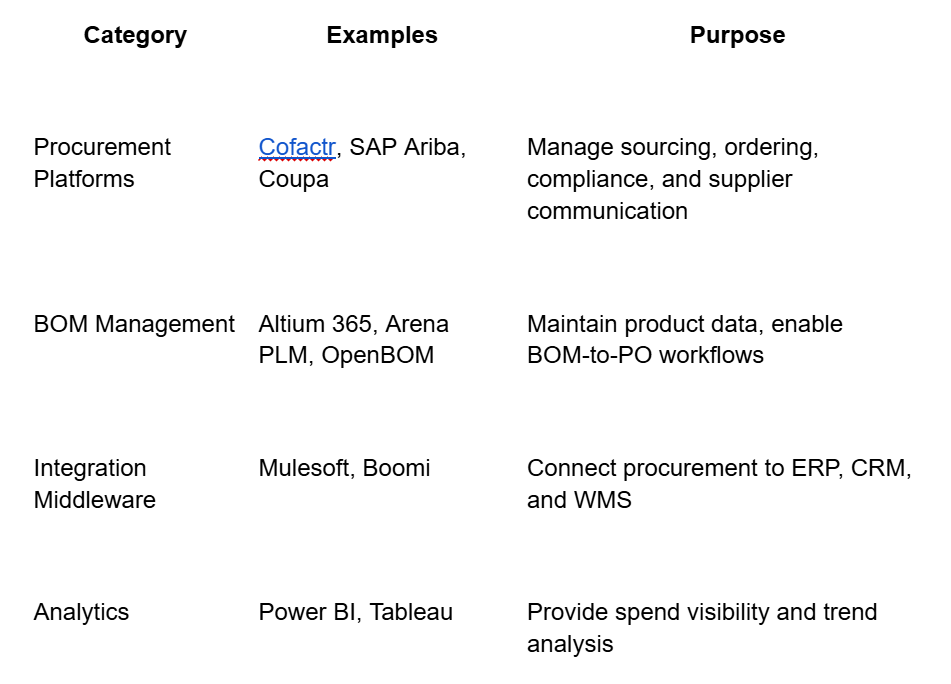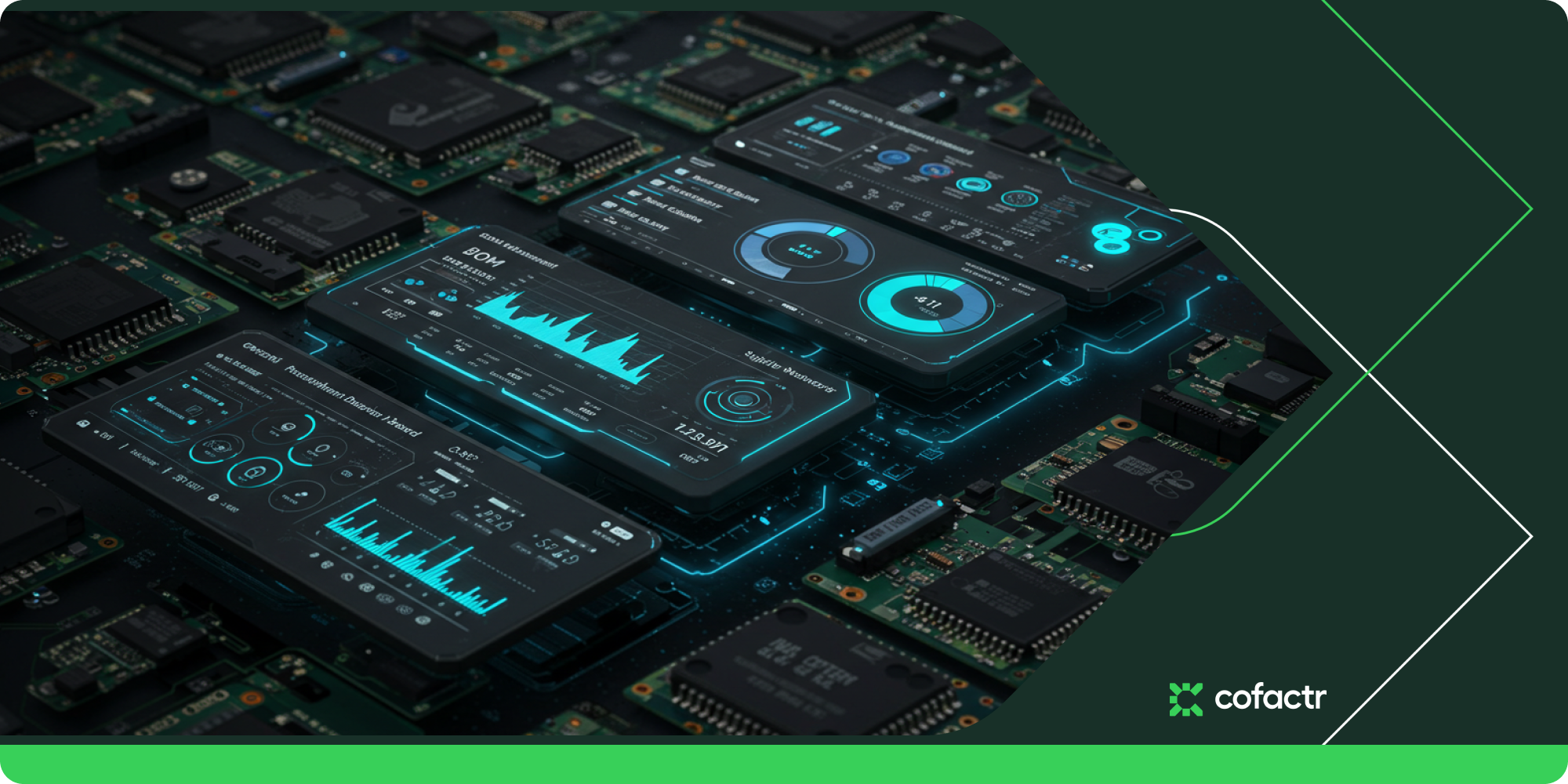Table of contents
But not to worry, procurement automation can turn that chaos into a well-oiled machine. By automating your procurement processes, you reduce errors, save time, and scale your operations without adding headcount.
In this article we show how procurement automation saves you both time and money. By automating routine tasks, you free up valuable resources for more strategic activities, which results in:
- Cost savings: Automated processes minimize errors, reduce maverick spend, and help you negotiate better terms with suppliers.
- Time savings: No more chasing approvals, manually creating POs, or sifting through spreadsheets. Spend less time on admin and more on growing your business.
Read More: Procurement Software: A Comprehensive Overview
Challenges in Hardware Startup Procurement
Before we dive into the solutions, let's acknowledge the challenges:
- Small teams wearing multiple hats: Engineers and founders often handle procurement, diverting focus from product development.
- Manual processes: Emails, spreadsheets, and phone calls dominate sourcing and order tracking.
- Data fragmentation: Supplier details, pricing, and lead times are scattered across shared drives and inboxes.
- High-risk environment: Long component lead times, single-source dependencies, and regulatory requirements (ITAR, AS6081, ESD standards).
- Scaling pain points: As production volumes grow, manual methods cause missed deadlines, stockouts, and costly overstocking.
Read More: The Outdated Playbook That’s Holding Back Hardware Startups
Core Components of Procurement Automation
Procurement automation isn’t just about buying software; it's about transforming your processes to meet the specific needs of the electronics manufacturing industry. Unlike generic procurement tools, automation tailored for hardware manufacturing takes into account the technical, stock, and pricing information unique to electronic components.
So, what are the key components of procurement automation for hardware startups? Here's a breakdown:
- BOM Matching: The first step is ensuring that the part numbers in your Bill of Materials (BOM) are valid, not obsolete, and not marked as NRND (Not Recommended for New Design). This is crucial for avoiding production delays due to discontinued or unavailable components. Once this validation is done, the BOM is linked directly to planning, which helps you project future needs, optimize your inventory, and set clear procurement goals. This check also confirms the correct manufacturer, normalizes manufacturer names (e.g., AMD and Advanced Micro Devices will always show up as Advanced Micro Devices), and ensures data consistency across your system.
- BOM to Planning: The system can integrate multiple BOMs and schedules, allowing you to aggregate demand. This helps in better demand forecasting, ensuring that orders are placed in advance and that inventory management is aligned with production needs.
- Automated Purchase Requisitions: Digital request forms that route approvals without email threads, using role-based rules.
- Supplier Onboarding & Management: Self-service portals for collecting banking details, certifications, and compliance documents.
- BOM-to-PO Conversion: Automatically generating purchase orders from BOM data, reducing manual entry errors.
- Inventory & Reorder Triggers: Automatic PO creation when stock levels fall below predefined thresholds.
- Invoice Matching: Three-way matching between PO, goods receipt, and supplier invoice to prevent overpayment.
- Compliance Checks: Automated validation for restricted materials, export controls, and quality standards.
Read More: Source-to-Pay in HMLV Electronics: A Quick Primer
When to Implement Procurement Automation
Wondering if it's time to automate? Consider these signs:
- You're consistently missing component delivery dates.
- Engineers spend more than 10% of their week on sourcing or admin tasks.
- BOM complexity exceeds 100 line items per product.
- You're preparing for a volume ramp-up or onboarding a contract manufacturer.
- You're experiencing more than 5% annual losses from maverick spend or supplier errors.
The biggest sign is that you're spending more time figuring out what to do than actually doing something. If you're constantly scrambling to understand what needs to be ordered, or chasing down approvals that are holding up production, it's time for automation. Procurement should help you move forward, not keep you stuck in planning paralysis.
Read More: The Right 3PL: A Cross-Functional Decision for Hardware Startups
Step-by-Step Implementation Roadmap
Ready to take the plunge? Here's a roadmap to guide you:
- Audit Current Processes: Map workflows from requisition to payment, noting all manual steps. Don’t go crazy, just an hour with stakeholders creating a simple flow chart.
- Clean Master Data: Confirm and standardize MPNs and manufacturers. Don’t skip this one! Your component data should be 100% validated or there will be trouble downstream.
- Select a Procurement Platform: Evaluate based on BOM integration, supplier portal capabilities, and compliance features.
- Integrate with Existing Systems: Ensure compatibility with ERP, inventory management, and accounting software.
- Pilot with a Single Category: Start with a manageable category like PCB fabrication or passive components.
- Train Internal Users and Suppliers: Provide quick-start guides, playbooks, and live demos.
- Expand in Phases: Roll out automation by category or geography.
- Monitor KPIs: Track cycle time, on-time delivery rate, and compliance scores.
Technology Stack for Hardware Procurement Automation
Choosing the right tools is crucial. Here's a breakdown:

Case Study: Salient Motion
Company: Aerospace and defense hardware startup
Problem: Manual BOM processing created 4–6 week procurement delays and frequent SKU mismanagement.
Solution: Implemented Cofactr’s Source-to-Pay + 3PL platform with automated BOM-to-PO conversion.
Results:
- 25% reduction in production cycle time
- 30% faster procurement process
- 100% improvement in SKU management
Read More: How Neros Technologies Scaled 10x Without Procurement Hires
Common Pitfalls and How to Avoid Them
Even the best-laid plans can go awry. Here's how to sidestep common mistakes:
- Poor data quality → Fix: Deduplicate and standardize records before go-live.
- Underestimating supplier onboarding → Fix: Include supplier enablement in rollout plan.
- Overcomplicating setup → Fix: Start with core automation features, expand later.
- Ignoring change management → Fix: Assign internal champions and provide training.
Read More: Change Management Strategies for Procurement Transformation
Key KPIs to Measure Success
Success isn't just about implementing software; it's about achieving results. Track these KPIs:
- Demand Planning-to-PO cycle time
- Supplier on-time delivery percentage
- Percentage of automated POs vs. manual POs
- Reduction in shortages and/or production delays
- Procurement and Engineering hours saved per month
Conclusion
For hardware startups, procurement automation is not just a time-saver—it’s a growth enabler. By digitizing and automating sourcing, ordering, and supplier management, startups can scale production without adding headcount, reduce risk, and maintain compliance in fast-moving markets.
Next Step: Assess your current procurement maturity and identify the highest-ROI automation opportunities. For electronics manufacturing, platforms like Cofactr offer a combined Source-to-Pay + e3PL model designed for the unique needs of hardware teams.
Want to make this easy? Schedule a free, no obligation Cofactr demo to see how we can help you automate price evaluation, component swaps, and much more.
Glossary
- BOM – Bill of Materials; list of raw materials, parts, and assemblies needed for a product.
- Maverick Spend – Purchases made outside of approved procurement channels.
- e3PL – electronics Third-Party Logistics; a warehouse 3PL with specialized capabilities for handling electronic components.
- ESD – Electrostatic Discharge; protection standards for electronics manufacturing.
- S2P – Source-to-Pay; process from sourcing to invoice payment.
- Cycle Time – Time from process initiation to completion.
Frequently Asked Questions
What is a Bill of Materials (BOM) and why does it matter in procurement?
A BOM is a complete list of raw materials, parts, and assemblies required to manufacture a product. In procurement automation, BOM integration allows instant generation of purchase orders without manual data re-entry.
What does “Maverick Spend” mean?
Maverick spend refers to purchases made outside of approved procurement processes, often leading to higher costs and compliance issues. Automation can enforce purchasing policies and preferred supplier use.
How does three-way invoice matching work?
It compares the purchase order, goods receipt, and supplier invoice to ensure accuracy before payment. This reduces overpayment risk and disputes.
What is a 3PL and how does it help hardware startups?
A Third-Party Logistics (3PL) provider handles warehousing, fulfillment, and sometimes procurement logistics, enabling startups to scale without building their own logistics infrastructure.
What compliance standards are relevant for electronics manufacturing?
Common standards include ESD (Electrostatic Discharge), MSL (Moisture Sensitivity Level), ITAR (International Traffic in Arms Regulations), and AS6081 (Counterfeit Electronic Parts Avoidance).
How soon can a hardware startup see ROI from procurement automation?
Many startups see measurable savings in cycle time, cost, and labor within 3–6 months, especially when targeting high-volume or high-complexity categories first.
What is Source-to-Pay (S2P)?
S2P is the full process from sourcing suppliers to paying invoices. For hardware startups, S2P systems can integrate sourcing, contract management, purchasing, and payment workflows into one platform.




